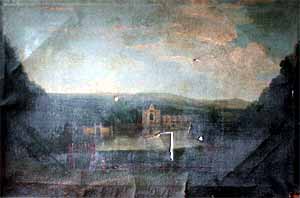Articles from the Thoroton Society Newsletter
A View of Newstead Abbey from Norton Conyers
As is always the case, something new is discovered just after your book has gone to press, and this is certainly true in this case. Only days after the publication of Newstead Abbey A Country House: Its Owners and Architectural History 1540-1931, Haidee Jackson, the curator, contacted us to say that a previously unknown painting had been brought to her attention.

This large oil painting, the property of Sir James and Lady Halina Graham of Norton Conyers in Yorkshire, is a view of the Abbey from across the Upper Lake. It is not in good condition, in fact, it is in desperate need of cleaning and professional restoration. The picture is not of the highest artistic quality and the composition is somewhat stagey. It appears to be by either a provincial journeyman artist or an amateur. The most likely candidate would appear be the Reverend Richard Byron, a younger brother of the 5th Lord Byron, whose view of the East Front painted in 1758 and presented by him to his nephew, the Earl of Carlisle at Castle Howard, now hangs in the West Gallery at Newstead (purchased in1998 from a private collection in Yorkshire). This large canvas may therefore have been painted, possibly from memory, by Richard Byron who had known Newstead in his youth but spent most of his adult life in County Durham and in Yorkshire. This would help to explain some of the obvious inaccuracies in the buildings portrayed. For example, the west front of the Abbey itself is shown with four tall bay windows whereas we know from many other visual sources that the house had only three tall bay windows before 1818. The picture appears to show an external staircase leading from one of these bay windows, something not shown in any of the contemporary views of the west front. The picture also shows Kennels Castle which was probably built around 1760 indicating that this painting was painted soon after this date. It has a very fine contemporary frame.
As with all the known images of Newstead Abbey this picture adds significantly to our knowledge of the history of the Abbey and particularly its surrounding landscape. This oil painting appears at first sight to be yet another view of the west front of Newstead Abbey seen from across the Upper Lake. In fact, this painting is taken from much further back (west) than most other views and includes a detailed representation, in the foreground, of the two arched gateways which led to the open ground in front of Folly Castle. These two gateways are shown in some detail in this painting. Their distinctly red colour suggests that they were built of brick (a rarity at Newstead). They may have had Gothic style decoration like that found on Folly Castle itself, though the present condition of the picture means that these details cannot be distinguished at present. Restoration and cleaning of this painting would allow us to see these gateways in far more detail. Between these gateways is a low battlemented wall with cannons on red-painted gun carriages pointing out across the lake. Whether this gun emplacement ever existed is open to question. There is no other evidence for its existence. A drawing by S H Grimm which shows the gateways is too distant to be able to make out the gun emplacement. The artist may have conflated the Battery - which still exists at the water’s edge - into this new position in order to emphasise the foreground where a lady and gentleman promenade. The couple’s costume confirms a mid-18th century date for the picture. The gentleman - in what might be termed naval attire - appears to be looking across the picture with either a telescope raised to his eye or a horn raised to his lips! Perhaps they are the 5th Lord and his wife, Elizabeth, and perhaps he is watching or signalling to the ships on the lake. The prominence given to the cannon and the ships on the lake suggests that the subject of this picture may be linked to the naumachia or mock sea battles which the 5th Lord, a former naval officer, is known to have staged here at Newstead. Such nautical pastimes were indulged by a number of English aristocrats in the 18th century (see Coope & Smith, 78).
This fascinating and problematic painting needs expert cleaning and restoration. This process may well reveal many answers to some of the questions raised about Newstead Abbey in this paper. It will, we are sure, transform this picture back to the significant image which it once was. At present this picture is on loan to Newstead Abbey and it is hoped that it will be acquired for the Nottingham Castle Museum’s Collection.
Dr Rosalys Coope & Pete Smith
< Previous